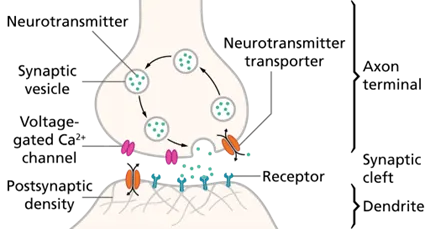Neurohumoral transmission is the process where nerve impulses release chemical messengers to transmit signals.
Definition:
- Neurohumoral transmission refers to the process by which a nerve impulse leads to the release of a chemical substance (neurotransmitter), which then acts on a target cell (neuron, muscle, or gland) to produce a specific physiological response.

Steps of Neurohumoral Transmission:
- Impulse conduction: Electrical signal travels down the axon of a neuron.
- Calcium influx: At the axon terminal, the action potential opens voltage-gated Ca²⁺ channels.
- Vesicle fusion: Calcium triggers the fusion of synaptic vesicles containing neurotransmitters with the presynaptic membrane.
- Neurotransmitter release: Neurotransmitters are released into the synaptic cleft.
- Receptor binding: Neurotransmitters bind to specific receptors on the postsynaptic membrane.
- Response generation: Receptor activation causes ion channel opening or second messenger activation → Excitatory or inhibitory response.
- Termination: Neurotransmitter action is stopped by:
- Reuptake into the presynaptic neuron
- Enzymatic degradation
- Diffusion away from the synaptic cleft
Sites:
- Neuro-neuronal (between neurons)
- Neuro-effector (between neuron and muscle/gland)
Click Here to Watch the Best Pharma Videos

